Water walls
Here, we describe the concept of walls, which aim not only at minimising heat losses, but also at collecting solar energy.
The traditional approach to energy saving in the construction industry consists in reducing heat losses by increasing insulation capacity of partitions. This way always means a negative thermal balance of the partition, regardless of how thick the insulation will be. The concept of the water walls aims at simultaneously using the gains of energy from the sun in order to achieve a positive balance.
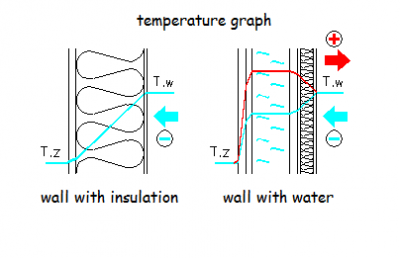
Due to extremely uneven distribution of solar energy in time, it is essential to build a heat storage, into which the radiation would be possibly directly introduced. For this purpose we use transparent containers with water, arranged behind a thermal shield constituted by the set of panes. Water has a heat capacity 5-times higher than concrete based on the weight and 3-times by volume. Consequently tanks with a capacity of approximately 100 liters/m2 correspond to the concrete wall of 30 cm thickness.
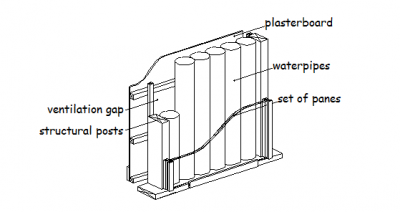
WATER WALL
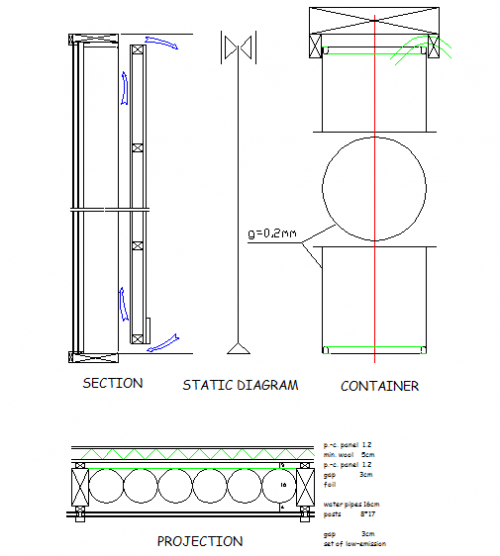
Capturing the sun's energy is inextricably linked to the issue of protection of the building against the excess of energy during warm periods. We are currently elaborating an effective method of building the water walls of southern orientation and a system for shading them in the summer.
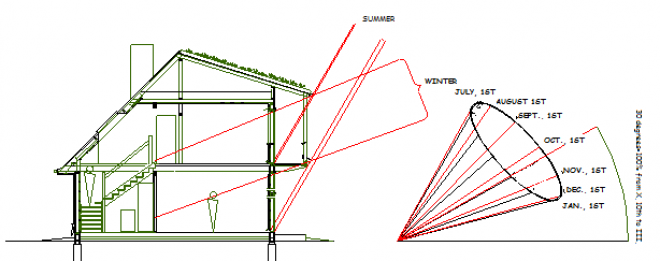
Cross section of one of the test houses currently built.
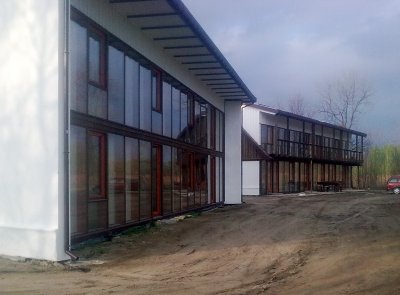
Southern facades of houses with water walls. The building in the foreground will have movable awnings on the ground floor.
Both buildings will be planted with wine and hops. Southern areas of roofs will be covered with plants.
Properly shaded water walls function as air conditioning in the summer. They particularly highly improve the microclimate in rooms with low heat capacity: in attics and in light, skeletal structures.
From an economic point of view, the key issue is the price of water containers. Per 1 mb of wall, 1 containers with a diameter of 16cm and height of about 230 cm are needed. When producing with blowing or welding technology with PET, market price for 1 piece should not exceed 10 zł, which accounts for 25 zł/m2. At that price of containers, the cost of building a water wall would not exceed the costs of typical wall of skeleton structure with mineral wool insulation (U=0.2Wm2K).
Partitions, examined by us, of south orientation have a positive energy balance even with respect to 2 coldest months of the year. With respect to 4 months of winter, surplus of energy from 1m2 allows to make up for the losses of 4m2 of traditional partitions with a coefficient of U=0.2W/m2K. We expect to acquire 80% of the energy for heating buildings from the sun with a slight increase in costs of erecting walls (or without any increase).
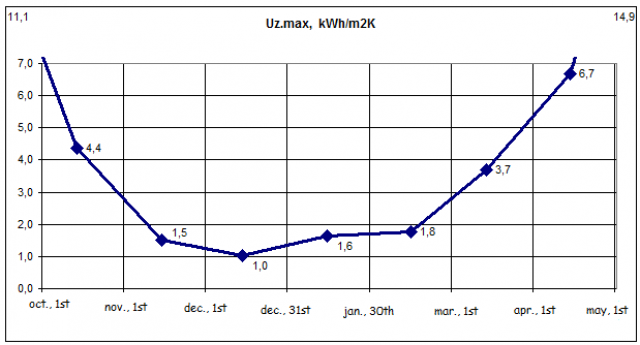
The maximum value of heat transfer coefficient for layers separating water pipes and the outside, with which the monthly heat balance throughout the partition is positive.
Climate data for Warsaw, southern orientation, radiation transfer coefficient g=0.7, shading coefficient z=0.95 interior temperature Tw=20 degrees C.
STATE OF KNOWLEDGE
Trombe collector walls are known and used, which consist in setting behind the pane a massive masonry wall, which captures solar energy and collects it thanks to its mass. Typically, these walls have two openings, top and bottom, which upon opening start a convective heat transfer from the zone between the pane and the wall into the interior.
A disadvantage of these structures is an unfavourable temperature distribution - wall is heated not from the indoor side, but from the outdoor side, which greatly increases heat dissipation. In our solution, there is no convective flow because water has a uniform temperature throughout its mass. Conversion of the radiation into heat is carried out on the black film inserted into the container pipe, and thus inside the water, which effectively prevents an increase of the surface temperature of the absorber, thus increasing the efficiency of the collector. An additional advantage is a much larger thermal capacity of water than the one of walls. Convective flow in Trombe walls caused indelible dust deposits on the pane from the air gap side. In our construction this gap with water tanks is tightly closed.
In the 80's, similar arrangements with water containers were tested in the US, but mainly as air conditioning. Opaque pipes made of metal sheet were used. New factors which changed the situation are: advances in the area of multiple glazed panels, new computational tools (hour method, standard climate model) and above all the development of plastics technology allowing the use of transparent and low-cost water tanks.
In Morocco, similar partitions using typical water bottles were tested. The objective was to improve the thermal standard for poor housing. We do not know other, contemporary works on the subject.
Our consultant in this project is dr hab.inż. Hanna Jędrzejuk from the Institute of Heat Engineering, Warsaw University of Technology.
